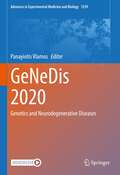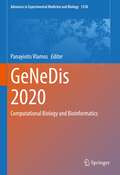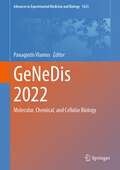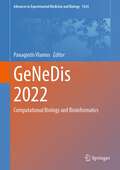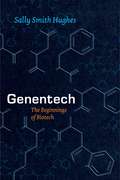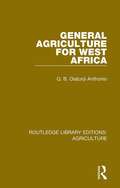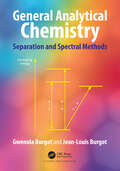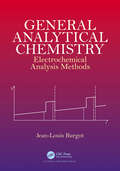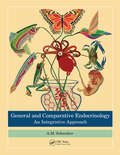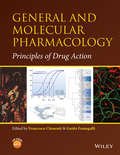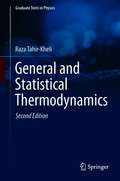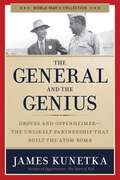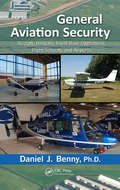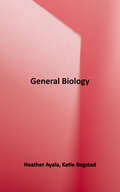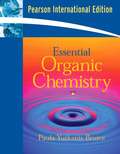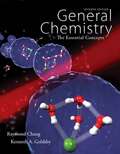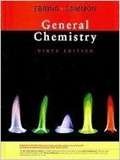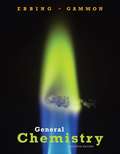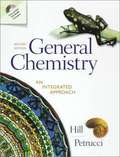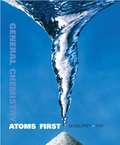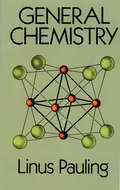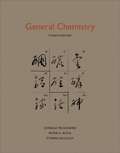- Table View
- List View
GeNeDis 2020: Genetics and Neurodegenerative Diseases (Advances in Experimental Medicine and Biology #1339)
by Panayiotis VlamosThe 4th World Congress on Genetics, Geriatrics, and Neurodegenerative Diseases Research (GeNeDis 2020) focuses on the latest major challenges in scientific research, new drug targets, the development of novel biomarkers, new imaging techniques, novel protocols for early diagnosis of neurodegenerative diseases, and several other scientific advances, with the aim of better, safer, and healthier aging. The relation between genetics and its effect on several diseases are thoroughly examined in this volume. This volume focuses on the sessions from the conference on Genetics and Neurodegenerative Diseases.
GeNeDis 2020: Computational Biology and Bioinformatics (Advances in Experimental Medicine and Biology #1338)
by Panayiotis VlamosThe 4th World Congress on Genetics, Geriatrics and Neurodegenerative Diseases Research (GeNeDis 2020) focuses on the latest major challenges in scientific research, new drug targets, the development of novel biomarkers, new imaging techniques, novel protocols for early diagnosis of neurodegenerative diseases, and several other scientific advances, with the aim of better, safer, and healthier aging. Computational methodologies for implementation on the discovery of biomarkers for neurodegenerative diseases are extensively discussed. This volume focuses on the sessions from the conference regarding computational biology and bioinformatics.
GeNeDis 2022: Neuroscientific Advances (Advances in Experimental Medicine and Biology #1425)
by Panagiotis VlamosThe 5th World Congress on Genetics, Geriatrics, and Neurodegenerative Diseases Research (GeNeDis 2022) focuses on the latest major challenges in scientific research, new drug targets, the development of novel biomarkers, new imaging techniques, novel protocols for early diagnosis of neurodegenerative diseases, and several other scientific advances, with the aim of better, safer, and healthier aging. This volume focuses on the sessions from the conference on Neuroscientific Advances.
GeNeDis 2022: Molecular, Chemical, and Cellular Biology (Advances in Experimental Medicine and Biology #1423)
by Panagiotis VlamosThe 5th World Congress on Genetics, Geriatrics and Neurodegenerative Diseases Research (GeNeDis 2022) focuses on the latest major challenges in scientific research, new drug targets, the development of novel biomarkers, new imaging techniques, novel protocols for early diagnosis of neurodegenerative diseases, and several other scientific advances, with the aim of better, safer, and healthier aging. This volume focuses on the sessions from the conference on Molecular Biology, Chemical Biology, and Cellular Biology.
GeNeDis 2022: Computational Biology and Bioinformatics (Advances in Experimental Medicine and Biology #1424)
by Panagiotis VlamosThe 5th World Congress on Genetics, Geriatrics and Neurodegenerative Diseases Research (GeNeDis 2022) focuses on the latest major challenges in scientific research, new drug targets, the development of novel biomarkers, new imaging techniques, novel protocols for early diagnosis of neurodegenerative diseases, and several other scientific advances, with the aim of better, safer, and healthier aging. Computational methodologies for implementation on the discovery of biomarkers for neurodegenerative diseases are extensively discussed. This volume focuses on the sessions from the conference regarding computational biology and bioinformatics.
Genentech: The Beginnings of Biotech
by Hughes Sally SmithIn the fall of 1980, Genentech, Inc. , a little-known California genetic engineering company, became the overnight darling of Wall Street, raising over $38 million in its initial public stock offering. Lacking marketed products or substantial profit, the firm nonetheless saw its share price escalate from $35 to $89 in the first few minutes of trading, at that point the largest gain in stock market history. Coming at a time of economic recession and declining technological competitiveness in the United States, the event provoked banner headlines and ignited a period of speculative frenzy over biotechnology as a revolutionary means for creating new and better kinds of pharmaceuticals, untold profit, and a possible solution to national economic malaise. Drawing from an unparalleled collection of interviews with early biotech players, Sally Smith Hughes offers the first book-length history of this pioneering company, depicting Genentech's improbable creation, precarious youth, and ascent to immense prosperity. Hughes provides intimate portraits of the people significant to Genentech's science and business, including cofounders Herbert Boyer and Robert Swanson, and in doing so sheds new light on how personality affects the growth of science. By placing Genentech's founders, followers, opponents, victims, and beneficiaries in context, Hughes also demonstrates how science interacts with commercial and legal interests and university research, and with government regulation, venture capital, and commercial profits. Integrating the scientific, the corporate, the contextual, and the personal, Genentech tells the story of biotechnology as it is not often told, as a risky and improbable entrepreneurial venture that had to overcome a number of powerful forces working against it.
General Agriculture for West Africa (Routledge Library Editions: Agriculture #13)
by Q.B. Olatunji AnthonioFirst published in 1979. This study examines various aspects of agriculture in West Africa. There is a strong chapter on the economics of agriculture and records, farm machinery, agricultural improvement, fish and the basics of crop and livestock production are all dealt with. The role of government policy in the improvement of agriculture is also examined. This title will be useful to undergraduates concerned with agriculture who want a good grounding before going on to their specialised fields of the applied sciences, as well as to those interested in commercial farming and policy makers in civil administration.
General Analytical Chemistry: Separation and Spectral Methods
by Gwenola Burgot Jean-Louis BurgotThis book provides key information about the instrumental analytical methods which are the most used in quantitative analysis. A theoretical knowledge of each method is discussed. The methods are illustrated with several examples covering a wide range such as pharmacy, biochemical, environmental and agrochemicals analysis. It is structured into three parts: the first one focuses on separation methods, the second covers the spectroscopic ones and the third part develops the thermal and the radiochemical methods.
General Analytical Chemistry: Electrochemical Analysis Methods
by Jean-Louis BurgotThis book is devoted to the quantitative electrochemical methods of analysis in solution. A theoretical knowledge of each method is discussed. The methods are illustrated with several examples covering a wide range of types of analysis. The book is divided in three parts. The first one is introductory. It recalls some definitions and some basic concepts of electrochemistry. The second part describes the methods themselves. Are studied voltametric methods, amperometry, potentiometry, conductometry, the electrogravimetry and coulometry. Some chapters are also dedicated to the chemical and electrochemical sensors. The third part consists in a supplementary theoretical knowledge of each method.
General and Comparative Endocrinology: An Integrative Approach
by A.M. SchreiberGeneral and Comparative Endocrinology: An Integrative Approach, takes a holistic approach to endocrinology, introducing students to the diverse facets of this interdisciplinary science ranging from the medical to comparative domains, while also exploring evolutionary, environmental, and conservation specializations within the field. The textbook is founded on the principle that students interested in the health sciences will benefit from understanding how proficiency in endocrine function among a diversity of organisms contributes to advances in modern medicine. Likewise, students intrigued by comparative physiology will benefit from the wealth of knowledge derived from medical/clinical endocrinology, the historical bedrock of the field. This textbook represents the modern field of endocrinology in its totality by addressing topics and recent advances not currently discussed in other introductory endocrinology textbooks. Key Features Introduces the broad and interdisciplinary scope of endocrinology. Provides clear chapter objectives and key concepts. Includes summary and synthesis questions for each chapter that are suitable for exams and quizzes. Includes a chapter devoted to endocrine-disrupting chemicals. Describes the roles played by the endocrine system in important health challenges related to appetite regulation, obesity, diabetes, and other diseases stemming from ‘mismatches to modernity’. Integrates evolutionary and comparative approaches to hormones and health.
General and Molecular Pharmacology
by Francesco Clementi Guido FumagalliWith a focus on functional relationships between drugs and their targets, this book covers basic and general pharmacology, from a cellular and molecular perspective, with particular attention to the mechanisms of drug action - the fundamental basis for proper clinical use- without neglecting clinical application, toxicology and pharmacokinetics. * Covers cell and molecular pharmacology, bringing together current research on regulation of drug targets, at a level appropriate for advanced undergrad and graduate students * Discusses the relevance of pharmacokinetics and drug development for the clinical application of drugs * Presents material from the perspective of drug targets and interaction, the theoretical basis of drug action analysis, and drug properties * Focuses on structure-function relationships of drug targets - informing about their biochemical and physiologic functions and experimental and clinical pathways for drug discovery and development * Has a companion website that offers a host of resources: short additional chapters about methodology, topics at the forefront of research, all figures and tables from the book, and Power Point slides
General and Statistical Thermodynamics (Graduate Texts in Physics)
by Raza Tahir-KheliThis textbook provides comprehensive information on general and statistical thermodynamics. It begins with an introductory statistical mechanics course, deriving all the important formulae meticulously and explicitly, without mathematical shortcuts. In turn, the main part of the book focuses on in-depth discussions of the concepts and laws of thermodynamics, van der Waals, Kelvin and Claudius theories, ideal and real gases, thermodynamic potentials, phonons and all related aspects. To elucidate the concepts introduced and to provide practical problem-solving support, numerous carefully worked-out examples are included. The text is clearly written and punctuated with a number of interesting anecdotes. The book also provides alternative solutions to problems and second equivalent explanations of important physical concepts. This second edition has been expanded to cover the foundations of superconductivity with new chapters on Cooper pairs, the Bogoliubov transformation, and superconductivity. It is suitable as a main thermodynamics textbook for upper-undergraduate students and provides extensive coverage, allowing instructors to ‘pick and choose’ the elements that best match their class profile.
The General and the Genius: Groves and Oppenheimer ? The Unlikely Partnership that Built the Atom Bomb
by James KunetkaTwo ambitious men. One historic mission. With a blinding flash in the New Mexico desert in the summer of 1945, the world was changed forever. The bomb that ushered in the atomic age was the product of one of history's most improbable partnerships. The General and the Genius reveals how two extraordinary men pulled off the greatest scientific feat of the twentieth century. Leslie Richard Groves of the Army Corps of Engineers, who had made his name by building the Pentagon in record time and under budget, was made overlord of the impossibly vast scientific enterprise known as the Manhattan Project. His mission: to beat the Nazis to the atomic bomb. So he turned to the nation's preeminent theoretical physicist, J. Robert Oppenheimer--the chain-smoking, martini-quaffing son of wealthy Jewish immigrants, whose background was riddled with communist associations--Groves's opposite in nearly every respect. In their three-year collaboration, the iron-willed general and the visionary scientist led a brilliant team in a secret mountaintop lab and built the fearsome weapons that ended the war but introduced the human race to unimaginable new terrors. And at the heart of this most momentous work of World War II is the story of two extraordinary men--the general and the genius.
General Aviation Security: Aircraft, Hangars, Fixed-Base Operations, Flight Schools, and Airports
by Ph.D, Daniel BennyAfter 9/11, the initial focus from the U.S. government, media, and the public was on security at commercial airports and aboard commercial airlines. Soon, investigation revealed the hijackers had trained at flight schools operating out of general aviation airports, leading to a huge outcry by the media and within the government to mandate security
General Biology
by Heather Ayala Katie RogstadGeneral Biology, Novare's high school biology text, combines up-to-date science with a Christian worldview as well as the mastery-based educational philosophy for which Novare is known. <p><p>Chapters start at the atomic level and progress to ever-larger scales: cells, genes, microorganisms, plants, animals, and human organ systems. Each chapter includes straightforward learning objectives, exercises that call for both the clear articulation of thoughts and full-sentence answers, and an organization of topics that steadily builds. The final chapters of the book survey ecology and the theory of evolution. <p><p>Like all Novare texts, mastery-based learning methods are an essential part of General Biology, propelling students not only to learn but also to substantially retain the content for years after completing the course. The book succinctly and logically covers a wide array of information in a modest number of pages. Vivid, appealing graphics draw students into mature engagement with the content. 536 pages, hardcover. Grade 10-12.
General Chemistry
by Bruce Averill Patricia EldredgeThe overall goal of the authors with General Chemistry: Principles, Patterns, and Applications was to produce a text that introduces the students to the relevance and excitement of chemistry. Although much of first-year chemistry is taught as a service course, Bruce and Patricia feel there is no reason that the intrinsic excitement and potential of chemistry cannot be the focal point of the text and the course. So, they emphasize the positive aspects of chemistry and its relationship to students’ lives, which requires bringing in applications early and often. In addition, the authors feel that many first year chemistry students have an enthusiasm for biologically and medically relevant topics, so they use an integrated approach in their text that includes explicit discussions of biological and environmental applications of chemistry. Topics relevant to materials science are also introduced to meet the more specific needs of engineering students.
General Chemistry
by Bruce Averill Patricia EldredgeThe overall goal of the authors with General Chemistry: Principles, Patterns, and Applications was to produce a text that introduces the students to the relevance and excitement of chemistry. Although much of first-year chemistry is taught as a service course, Bruce and Patricia feel there is no reason that the intrinsic excitement and potential of chemistry cannot be the focal point of the text and the course. So, they emphasize the positive aspects of chemistry and its relationship to students' lives, which requires bringing in applications early and often. In addition, the authors feel that many first year chemistry students have an enthusiasm for biologically and medically relevant topics, so they use an integrated approach in their text that includes explicit discussions of biological and environmental applications of chemistry. Topics relevant to materials science are also introduced to meet the more specific needs of engineering students.
General Chemistry: The Essential Concepts
by Raymond Chang Kenneth GoldsbyThe seventh edition of General Chemistry continues the tradition of presenting only the material that is essential for a one-year general chemistry course. It strikes a balance between theory and application by incorporating real-world examples; helping students visualize the three-dimensional atomic and molecular structures that are the basis of chemical activity; and developing problem-solving and critical thinking skills. Although the seventh edition incorporates many impressive features, such as conceptual idea review, animations correlated to the text, and hand-sketched worked examples, General Chemistry is still 200 to 300 pages shorter and much less expensive than other two-semester textbooks. Dr. Chang and Dr. Goldsby’ concise-but-thorough approach will appeal to efficiency-minded instructors and value-conscious students.
General Chemistry
by Darrell Ebbing Steven D. GammonGENERAL CHEMISTRY is better than ever with this eleventh edition. It includes essential updates--such as modern artwork, higher integration with OWLv2, revised end-of-chapter questions, added Capstone Problems, narrative revisions, and more--to help you succeed in your chemistry course.
General Chemistry: An Integrated Appraoch
by John William Hill Ralph H. PetrucciMore than any other, this book offers balance - in the topics presented, in its approach to problem solving, and in its presentation of the subject of chemistry. Integrated coverage of organic and biochemistry; integrated applications; integrated tools that foster operational problem-solving and conceptual understanding; and an integrated media learning program. Expanded coverage of key chemistry topics such as organic chemistry, biochemistry, material science, and environmental chemistry.
General Chemistry: An Atoms-first Approach
by John E. Mcmurry Robert C. FayThis text tells a cohesive story about chemistry that follows an intuitive logic by progressing from the simplest building blocks to successively more complex concepts. It follows a unified thread of ideas that help students build a better foundation and ultimately gain a deeper understanding.
General Chemistry
by Linus Pauling"An excellent text, highly recommended." -- ChoiceWhen it was first published, this first-year chemistry text revolutionized the teaching of chemistry by presenting it in terms of unifying principles instead of as a body of unrelated facts. Those principles included modern theories of atomic and molecular structure, quantum mechanics, statistical mechanics and thermodynamics. In addition, Dr. Pauling attempted to correlate the theories with descriptive chemistry, the observed properties of substances, to introduce the student to the multitude of chemical substances and their properties. In this extensively revised and updated third edition, the Nobel Prize-winning author maintains an excellent balance between theoretical and descriptive material, although the amount of descriptive chemistry has been decreased somewhat, and the presentation of the subject, especially in relation to the nonmetals, has been revised in such a way as to permit greater correlation with the electronic structure of atoms, especially electronegativity.The principles of quantum mechanics are discussed on the basis of the de Broglie wavelength of the electron. The quantized energy levels of a particle in a box are derived by means of a simple assumption about the relation of the de Broglie waves to the walls of the box. No attempt is made to solve the Schrodinger wave equation for other systems, but the wave functions of hydrogen-like electrons are presented and discussed in some detail, and the quantum states for other systems are also covered. Statistical mechanics is introduced before thermodynamics, and the discussion of thermodynamics is based on it. This arrangement reflects the author's belief that beginning students can understand statistical mechanics better than chemical thermodynamics.Aimed at first-year college students who plan to major in chemistry or closely related fields, the book is written in a logical, clear and understandable style. In addition, many excellent figures are included, along with numerous problems and 75 pages of appendixes covering such topics as symmetry of molecules and crystals, hybrid bond orbitals, and magnetic properties of substances.
General Chemistry, 4th Edition
by Donald A. Mcquarrie Peter A. Rock Ethan B. Gallogly University Science Books StaffThis new fourth edition of General Chemistry takes an atoms-first approach from beginning to end. In the tradition of McQuarrie's many previous works, it promises to be another ground-breaking text. This superb new textbook combines the clear writing and wonderful problems that have made McQuarrie famous among chemistry professors and students worldwide. Presented in an elegant design with all-new illustrations, it is available in a soft-cover edition to offer professors a fresh choice at an outstanding value. Student supplements include an online series of descriptive chemistry Interchapters, a Students Solutions Manual, and an optional state-of-the-art Online Homework program. For adopting professors, an Instructor's Manual and a CD of the art are also available. NOT AVAILABLE IN NORTH AMERICA AND CANADA "McQuarrie is a genius. " Harry Gray, Caltech "Atoms First seems to be the flavor of the year in chemistry textbooks, but many of them seem to be little more than rearrangement of the chapters. It takes a master like McQuarrie to go back to the drawing board and create a logical development from smallest to largest that makes sense to students. " Hal Harris, University of Missouri-St Louis "McQuarrie's book is extremely well-written, the order of topics is logical, and it does a great job with both introductory material and more advanced concepts. Students of all skill levels will be able to learn from this book. " Mark Kearley, Florida State University
General Chemistry (AP Edition)
by Darrell D. Ebbing Steven D. GammonKnown for its carefully developed, thoroughly integrated approach to problem solving, this market-leading text emphasizes the conceptual understanding and visualization skills essential for first-year chemistry and science majors. The new technology program reinforces the approach of the text and provides a complete solution for teaching and learning.The Eighth Edition retains the hallmark pedagogical features of the text and builds upon the conceptual focus and art program. Students also benefit from online homework in the technology program, which features an extensive database of questions drawn from the text.In order to reinforce major chemical concepts, the authors present a proven six-part approach to problem solving that includes Example, Problem Strategy, Solution, Answer Check, Exercise, and corresponding End-of-Chapter Problems, many of which are presented in matched pairs.
